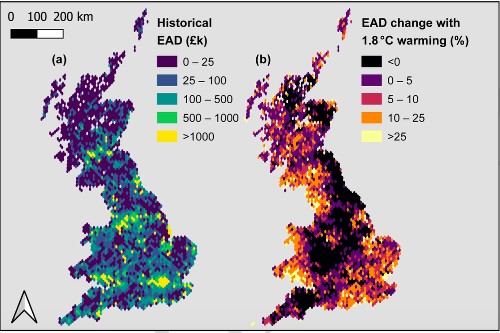
Maps show historical expected annual flood damage (EAD) in GBP billion at 2020 values, and calculated EAD percentage increase with 1.8 degrees global warming. University of Bristol and Fathom
Annual damage caused by flooding in the UK could increase by more than a fifth over the next century due to climate change unless all international pledges to reduce carbon emissions are met, according to new research.
The study, led by the University of Bristol and global water risk modelling leader Fathom, reveals the first-ever dataset to assess flood hazard using the most recent Met Office climate projections which factor in the likely impact of climate change.
Its findings show the forecasted annual increase in national direct flood losses, defined as physical damage to property and businesses, due to climate change in the UK can be kept below 5% above recent historical levels. But this is only on the proviso that all countries fulfil the ambitious pledges they signed up to at COP26 and also that countries, including the UK, which made further Net Zero commitments, actually achieve these on time and in full.
If the COP26 and Net Zero promises are not collectively met, the study shows the annual cost of flooding in the UK over the next century could grow by between 13% and 23%, depending on different levels of climate extreme projections.
Lead author Paul Bates, Professor of Hydrology at the University of Bristol and Chairman of Fathom, said: "For the first time this flood model gives us a more accurate and detailed picture of the impact of climate change on the risk of flooding in the future across the UK. The results are a timely warning to the country's political leaders and business sector that global commitments to significantly reduce carbon emissions must be taken very seriously, and ultimately take effect, in order to mitigate increased losses due to flooding."
The sophisticated data has also highlighted the places in the UK where risks will increase most rapidly, even under the best-case scenario where global warming is limited to 1.8 degrees C. These include South East England, South Wales, North West England and Central Scotland, especially densely populated cities such as London, Cardiff, Manchester, Glasgow, and Edinburgh, where damage increases of more than 25% are possible.
Conversely, the new model indicated flood hazards in North-East and Central England as well as Eastern and Northern Scotland change very little from the present day.
"Although the most optimistic climate scenarios see only modest increases in flood losses at a national level, these new data demonstrate how this conceals dramatic variations across the country, with some places seeing large changes and others very little. This is a result of changing patterns of future rainfall, river flow and sea level rise, and this leads to the regional differences we predict," said Professor Bates.
"We found that flooding increases most in places where risk is already high now, so the best thing we can do to prepare for the impact of climate change is to strengthen flood management in currently at-risk areas, and this will bring immediate economic and social benefits as well."
The modelled estimates of historical flood risk, which are based on actual river flow, rainfall, and tide-surge observations as well as climate model projections, match well with data on flood losses from the Association of British Insurers, and shed new light on the financial toll of flooding. Previous studies by other research groups have already shown that historical UK economic losses due to flooding were three times less than the Government's estimates, but this is the first time the observed losses have been replicated and corroborated by a computer model.
The team of researchers plan to produce analysis for other countries across the world, furthering our understanding of how climate change is likely to affect flood risk globally.
Co-author Dr Oliver Wing, Chief Research Officer at Fathom and Honorary Research Fellow at the University of Bristol, said: "This study, which harnesses new data and the very latest modelling techniques, validates Fathom's UK Flood Map and has given a new level of insight into the impact of climate change on flooding in future.
"The modelling provides clear evidence that flood risk needs to be a bigger international priority and that current governance doesn't go far enough. While the majority of the nation's future flood risk already exists today, it is strongly in the UK's interest to exercise leadership in global carbon emission reduction efforts, both by example and as part of global diplomatic initiatives."
Paper
'A climate-conditioned catastrophe risk model for UK flooding' by Paul D. Bates et al in Natural Hazards and Earth System Science.






